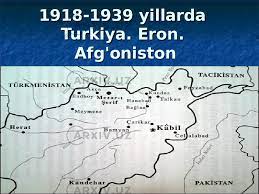SHARE WITH FRIENDS:
Iran and Afghanistan in 1918-1939
PLAN:
-
Iran's domestic and foreign policy.
-
Afghanistan interior
-
Foreign policy.
In 1988, Iran was a de facto semi-colony of Great Britain and Tsarist Russia. Great Britain began to completely occupy Iran at the beginning of 1918. The British were primarily interested in Iranian oil and Central Asian cotton. The aim was to keep Iran in a semi-dependent state and prevent national liberation movements from spreading to India. In 1919, the national liberation struggle began in the country. A great uprising took place in Tabriz under the leadership of Mohammad Khiyabani, and he seized power and established "Azodistan". Gilan Soviet Republic was established in the city of Resht.
On February 1921, 21, the military led by Reza Khan staged a coup d'état in Tehran. Although Reza Khan remained the Minister of Military Affairs, he practically took power into his own hands. The new government was forced to cancel the Anglo-Iranian Treaty of 1919 due to the political mood in the country. However, Great Britain's position was maintained.
The national liberation movement of the Iranian people in 1919-1922 did not go without a trace. As a result, Great Britain was forced to withdraw its army from Iran. But since 1922, Iran began to get closer to the United States. Leased oil drilling works in 5 provinces. But it was canceled soon after. Because their influence was strong in the Anglo-Iranian oil company.
In 1920-1922, serious changes were made to strengthen the central government in the country. For example, the resistance of the separatist forces was suppressed. Armed forces of various forms were united into a single army. These changes were related to the name of Reza Khan. In October 1923, he took the post of prime minister. On October 1925, 31, the Iranian Parliament (Majlis) announced the overthrow of the Kojar dynasty and the transfer of power to Reza Khan. On December 12, Reza Khan was declared the king of Iran.
A number of reforms were carried out in the colony. Kholisa was allowed to sell land. Money tax was introduced. State land became available for rent. Secular schools were also opened. Tehran University was opened in 1934. In 1935, a law was passed on women walking without a veil.
At the end of the First World War, Afghanistan was considered an independent country, but in practice it was a dependent country of Great Britain. Forces against the existing socio-economic and political order have also emerged in the country. This force was called "Movement of Young Afghans". Their goal was to achieve state independence and establish free business relations. In such circumstances, in February 1919, a palace conspiracy was organized. As a result, Amir Habibullah Khan was killed. Orno-nullah Khan, the son of Habibullah Khan, took the throne. He was closely associated with the young Afghan movement. On February 1919, 28, Amonu Khan declared Afghanistan an independent country.
Great Britain could not tolerate the independent policy of the Afghan state. He attacked Afghanistan on May 1919, 3 in order to make it a submissive country, thus starting the third Anglo-Afghan war. On August 8, an Anglo-Afghan treaty was signed in Rawalpindi. The event also meant the recognition of an independent Afghan state. The first Constitution of the state of Afghanistan, adopted in 1923, played a role in this. The power of tribal chiefs was limited and they were deprived of the right to collect state taxes. In January 1929, the government of Amonullah Khan was overthrown. Bachai Sako, a supporter of reaction, took the throne of the emirate. The new government canceled the reforms initiated by the young Afghans. In October 1929, they took power under the leadership of General Mohammad Nadir. Bachai Sako was overthrown.
In 1931, the new Constitution of the country was adopted. It was a new step in the transformation of Afghanistan from an absolute monarchy to a constitutional monarchy. After the death of Nadirshah in 1933, his son Mohammad Zahirshah took the throne. Like his father, he followed the path of deepening national and market relations in the economy.
Afghanistan's foreign policy has not always been consistent. During the reign of Nadirshah, Afghan-Soviet relations began to recover. On June 1931, 24, an agreement on neutrality and non-aggression was signed between Afghanistan and the Soviet state.
In 1941, at the request of the Great Britain and the Soviet state, all German and Italian citizens were expelled from the territory of Afghanistan, except for the employees of the embassies. Afghanistan maintained its neutrality throughout the war.
Control questions.
-
What years did the national liberation movement take place in Iran?
-
Who was declared the king of Iran on December 1952, 12?
-
1 – which country was Afghanistan dependent on after World War?
-
When was Afghanistan declared independent?
-
Who is Bachai Sako?
